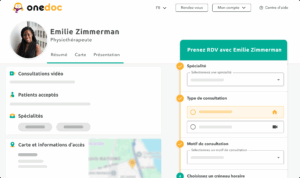
Opening your own physiotherapy clinic is a rewarding venture, but it requires good preparation — both administratively and in choosing the right tools for your future activity.
From defining your project to the daily management of your clinic, discover the 6 steps to follow to open a physiotherapy clinic in Switzerland.
1. Define your project for your physiotherapy clinic
First of all, take time to lay the foundations of your project.
Do you plan to work alone or as a team? Are you setting up in a large city or in a rural area? Will you serve a general clientele or specialise (sports rehabilitation, paediatrics, etc.)?
Conducting a local market study will help you identify patient needs, the competition and the potential in your region. This initial phase will also let you assess the ideal size of your clinic — useful when defining your budget.
What is the most common legal form for medical practices?
For an individual practice, the sole proprietorship remains the most common choice: simple to establish, low setup costs, direct billing with a personal RCC. As teams grow and business responsibilities increase, many practitioners however choose a LLC (Sàrl) or a corporation (SA) to limit risks and structure the organisation.
2. Budget for the opening of your physiotherapy clinic
Before you get started, it’s helpful to have an order of magnitude. To the question how much does it cost to open a physiotherapy clinic in Switzerland, the “KoDa – cost data” study by Physioswiss indicates that the average investment in equipment and materials for a clinic is approximately CHF 54 500 (treatment tables, devices, furniture, IT, small equipment). On top of that, you should add around CHF 52 000 annually in rent and infrastructure costs for a medium‑sized clinic. These are national averages and can vary considerably depending on region, clinic size and level of equipment desired.
Here are the main spending areas for a physiotherapy clinic:
- Premises and infrastructure (rent, utilities, possible renovations)
- Equipment and materials (around CHF 54 500 on average for a complete clinic)
- Digital tools (online booking, resource management, billing, …)
- Insurances and social charges (professional liability, AVS, LPP, etc.)
- Administrative and advisory fees (cantonal fees, accounting firm, legal support)
- Marketing and visibility (website, branding, online presence)
The rest of the work involves putting together a business plan and linking your costs with your forecasted revenues (billable hours, fee structure, occupancy rate) and planning a safety margin for unforeseen events.
Main spending areas for a physiotherapy clinic:
- Premises and infrastructure (rent, utilities, possible renovations)
- Equipment and materials (around CHF 54 500 on average for a complete clinic)
- Digital tools (online booking, resource management, billing, …)
- Insurances and social charges (professional liability, AVS, LPP, etc.)
- Administrative and advisory fees (cantonal fees, accounting firm, legal support)
- Marketing and visibility (website, branding, online presence)
The rest of the work involves putting together a business plan and linking your costs with your forecasted revenues (billable hours, fee structure, occupancy rate) and planning a safety margin for unforeseen events.
3. What administrative steps are required to open a physiotherapy clinic in Switzerland?
To open a physiotherapy clinic in Switzerland, you will need to meet certain criteria and obtain the necessary authorisations:
- Check that your diploma as a physiotherapist is recognised in Switzerland.
- Submit an application for a licence to practise to the health service of your canton.
- Apply for your RCC number so you can bill your services to the insurers.
- Register yourself as an independent practitioner with the AVS compensation fund.
- Take out a professional liability insurance.
- Ensure your premises meet cantonal standards (hygiene, safety, accessibility) and, if necessary, obtain an operating licence.
The main steps are similar from canton to canton, but the required documents, deadlines and fees may vary. If you’re wondering how to obtain a cantonal licence for physiotherapists, the easiest thing is to refer directly to the instructions of the health service of the canton where you plan to set up.
Choosing the right legal status to open a physiotherapy clinic
In Switzerland, you can choose from several legal forms: sole proprietorship, LLC (Sàrl) or corporation (SA), depending on your situation and ambitions. The choice depends on whether you operate alone or with others, and the level of protection you desire.
4. Find and fit out suitable premises for your physiotherapy practice
The choice of your premises is crucial. It must be readily accessible, well‑lit and compliant with hygiene and safety standards.
Choose a location close to public transport or parking, and ensure good accessibility for people with reduced mobility.
Also think about the atmosphere: a soothing environment promotes patient relaxation and makes waiting time less of a burden.
5. Equip yourself with the right digital tools
Digitalisation of physiotherapy practices is no longer a mere convenience — it’s a genuine lever for efficiency and quality of care. From appointment management, billing, patient communication to treatment tracking, the best software for physiotherapists in Switzerland are those that help you centralise as many tasks as possible in one place.
With OneDoc, you have an all‑in‑one solution specially designed for physiotherapists in Switzerland:
- Online booking for physiotherapists: Highly sought by patients, this lets them book a slot from your availability whenever they like.
- Automated billing with OneDoc Invoice: Bill all services at correct rates for your sessions (LAMal, AA/AI/AM/out‑of‑convention) directly in software compliant with Swiss standards.
- Teleconsultation: Perfect for first consults, some follow‑ups, interim assessments or remote advice when a physical presence isn’t essential.
Already using medical software?
OneDoc is compatible with ePhysio, PhysioApp, MediOnline and other Swiss medical software. You can thus keep your habits while benefiting from optimized online‑booking, automated tools for clinic management and a better experience for your patients as well as your team.
6. Launch your physiotherapy clinic: give visibility to your activity and build patient loyalty
The success of a physiotherapy clinic largely depends on its ability to attract and retain patients. In practical terms, when you’re wondering how to attract patients to a physiotherapy clinic, the answer today lies in a simple yet structured marketing strategy, with a strong presence where patients are searching: online. That’s why it’s essential to work on accessible and effective marketing strategies for physiotherapists.
In practice, this begins with creating a website for your physiotherapy clinic—clear, reassuring and mobile‑friendly. Complement it with:
- An optimised Google Business Profile listing (address, hours, photos, link to online booking).
- A presence in high‑quality online directories, like OneDoc, to be easily found by new patients.
- Targeted social media channels (e.g., content around prevention, movement, rehabilitation).
Thanks to these different channels you can increase your online visibility and thus attract and retain a loyal patient base.
7. Manage accounting and tax obligations as a self‑employed physiotherapist
Once your clinic is operational, it’s essential to master the financial side.
As a self‑employed physiotherapist, you’re required to:
- Keep either full or simplified accounting records
- Declare your income to the AVS (Swiss social security)
- Manage LPP contributions and social insurance (if you have employees)
- Check if your turnover exceeds CHF 100 000 — if so, you’ll be subject to VAT
Many practitioners choose to work with a fiduciary firm specialised in the medical field, which saves time and avoids tax mistakes. It’s worth noting that OneDoc Invoice helps you save time thanks to automatic invoice reconciliation and comprehensive accounting exports.
Going further: open a specialised physiotherapy clinic for athletes or in paediatrics
Once your activity is launched, you may choose to differentiate yourself by developing a targeted expertise. For example, opening a sports rehabilitation clinic involves additional specific equipment for strengthening and re‑athletisation (technical platform, assessment devices, movement space), and a stronger field presence (partnerships with clubs, gyms, sports doctors and participation in sports events). Your marketing will also become more targeted, aiming directly at athletes and their coaches.
Similarly, specialising in paediatric physiotherapy requires specific training, adapting your premises (kid‑friendly space, equipment adapted to children, longer consultation times) and close collaboration with paediatricians, schools and parents.
In all cases, the specialisation mainly affects your positioning, priority investments and partner networks, while relying on the same administrative and organisational foundation as opening a standard physiotherapy clinic.
Opening a physiotherapy clinic in a nutshell
Opening a physiotherapy clinic is an exciting project that gives you the freedom to practice according to your vision of care.
By following these steps, surrounding yourself with reliable partners and relying on appropriate tools, you’ll maximise your chances of building a sustainable and fulfilling practice.
 Discover OneDoc for physiotherapists!
Discover OneDoc for physiotherapists!

 Good to know! In addition to the premises, you’ll need to invest in equipment suited to your physiotherapy profession. Check out our dedicated article to discover the list of
Good to know! In addition to the premises, you’ll need to invest in equipment suited to your physiotherapy profession. Check out our dedicated article to discover the list of 





